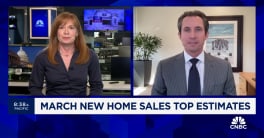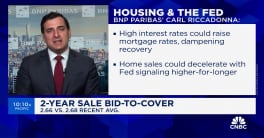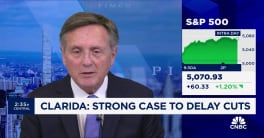Condominium sales were the main driver of the 2.0% rise in existing home sales in May, which came in higher than the 1.2% gain expected by economists.
Condo sales rose 5.5% in May, more than reversing the 5.2% monthly drop in April, while single family home sales rose 1.6% in the month to 4.99 million units against the 4.95 million sales expected.
"Even with such a massive boost from condos, it did not even make a dent in the month's supply of condos which remains at 14.2 months," noted Charmaine Buskas, senior economics strategist from TD Securities.
Total housing inventories came in at a 10.8-month supply in May, up from the 11.2-month supply in April.
"Until there is a measurable and sustained reversal in the inventory of homes, we are unlikely to see any improvement in housing fundamentals," Buskas added.
The report released from the National Association of Realtors also showed the national median existing home price was $208,300 in May, up from the revised April figure of $201,200 but representing an 8% decline from last year.
Despite the rise in sales, this is still the third consecutive month that existing home sales have remained below the five million mark.
"The annualized pace of sales appears to have stabilized at a very depressed range of 4.9-5.0mm," wrote T.J. Marta, a fixed income strategist from RBC Capital Markets. "One could make out a bottoming of sorts to the 'housing' story, insomuch as sales appear to be forming a bottom. However, the y/y price declines continue, and this loss of net wealth is going to weigh on consumers' balance sheets long after the tax rebate checks are spent."
Dimitry Fleming of ING Bank questioned whether a bottom in the housing market can be called, reminding clients that in late 2006 markets were "tricked" into believing a bottom had been reached before sales entered a "gruesome" 25% downslide.
"The May existing home sales are based on buying decisions made in March/April, but since then unemployment and mortgage rates have risen further and consumers have moved closer to a breakdown," he wrote in a client note.
"We doubt a further recovery is at hand. Note too that the sharp rise in April pending home sales (+6% MoM) has only partially fed through into actual sales. This is proof that financing conditions are still tight and buyers remain frightened to complete the home purchase while staring in the face of double-digit price declines."
Ian Shepherdson, chief U.S. economist at High Frequency Economics, said part of the reason for the higher sales in May can be attributed to the early Easter, meaning there were no disruptions to real estate activity in April.
"Next month's numbers should be weaker. Over the past few months the rate of fall of existing sales has slowed, as it did in early 06 and again in early 07; neither pause lasted, and we expect the same fate this time," he wrote in a note to clients. "Plunging prices and massive inventory are huge disincentives to home buying."
Existing-home sales, which include single-family, townhomes, condominiums and co-ops, are based on transaction closings. This differs from the U.S. Census Bureau's series on new single-family home sales, which are based on contracts or the acceptance of a deposit
By Stephen Huebl and edited by Cristina Markham







